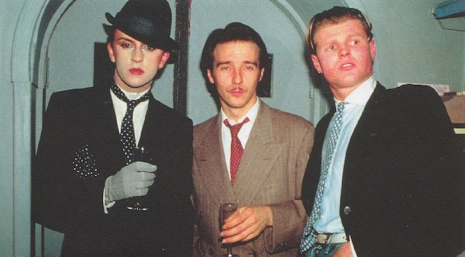
The Blitz Club where the Eighties were invented.
Punk was boring. Punk was dead. Punk stopped being interesting when it became chart music. In its place came New Wave—which was really just more of the same played with jangly guitars by bands with a taste for Sixties music. The next really big thing was the utter antithesis of punk. Elitist, pretentious, preening, vain, camp yet utterly inventive.
It was called “the cult with no name”—because nobody knew what to call it. It didn’t fit any easy categorization. There were soul boys, punks, rockabillies, with a taste for dance music and electronica all in the mix. It was the press who eventually pitched up with the tag New Romantics which stuck.
I was never quite sure what was supposed to be romantic about the New Romantics. They weren’t starving in garrets or brokenhearted, writing poetry, indulging in absinthe or committing suicide by the dozen. They were all dolled-up to the nines, flaunting it out on the streets—demanding to be seen.
It had all started with Rusty Egan and Steve Strange running a club night playing Bowie, Roxy Music and Kraftwerk at a venue called Billy’s in 1978.
Egan was a drummer and DJ. He was in a band with ex-Sex Pistol Glen Matlock called Rich Kids which featured Midge Ure on vocals.
Strange had been inspired to move to London and form a punk band after he saw the Sex Pistols in concert. He moved out of Wales and formed The Moors Murderers. The band included punk icon Soo Catwoman, guitarist Chrissie Hynde and Clash drummer Topper Headon. Together they recorded one notorious single “Free Hindley.”
The same year, Egan, Strange and Ure formed Visage—which was to become a catalyst for the New Romantics in 1980 with their hit single “Fade to Grey.”

Visage: Steve Strange, Midge Ure and Rusty Egan in 1978.
But we’re getting ahead of ourselves, so let’s be kind and rewind.
1978: Egan and Strange move their club night to a wine bar-cum-restaurant-cum-dance-club called the Blitz. Egan was the DJ. Strange was on the door. Strange has a strict door policy. No one gets in unless they dressed like superstars.
The club nights coincided with a massive stock sale by film and theatrical costumiers Nathan and Berman’s. This was where Adam Ant bought his famous hussars’ jacket—the very one worn by David Hemmings in The Charge of the Light Brigade.

Adam Ant and David Hemmings’ jacket from ‘The Charge of the Light Brigade.’
It was Nathan and Berman’s stock that supplied the New Romantics with their look. A mix of tartan and tweed—Victoriana, 1930s suits, pirate costumes, Napoleonic outfits. These were all snapped up for ridiculously low prices—cheaper than a pair of jeans down the King’s Road. Suddenly, the bright young things were all glamorous and beautiful dancing robotically to Kraftwerk’s “Showroom Dummies.” Oh, the irony.
Egan and Strange started a cultural revolution with Blitz. Pull one thread from all these beautiful gowns and you’ll find a pop culture history of the 1980s—Spandau Ballet, Duran Duran, Boy George, Leigh Bowery and Taboo, to electronica, Ultravox, and eventually on to rave culture and beyond.
Why? and How? did it happen—you may well ask. It was the happy alignment of talent and ambition in the same place at the same time. Sounds easy, doesn’t it? But it needed three things to get it going:
1. Music. Rusty Egan bringing together disparate people with a similar taste in music, fashion and ideas by playing Bowie, Ferry, Kraftwerk and Neu.
Egan was so enamoured with Kraftwerk he traveled to Germany to speak with the band and obtain more of their records.
2. Place. First Billy’s then the Blitz Club. Place can’t be over emphasized. Bring people to one location where it’s their club just for one night. Where they can behave how they like. Talk to other like-minded people. Inspire each other. Share ideas. Blitz brought together artists, musicians, filmmakers and designers. Spandau Ballet were basically the house band. They rubbed shoulders with members of Magazine and Ultravox and Tubeway Army. Barry Adamson. Boy George. Marilyn. John McGeoch. Even Phil Lynott—who was regular. Then designers like John Galiano, Stephen Jones and artists like Grayson Perry. Blitz was a laboratory where the experiments for the eighties began.
3. Catalyst. Steve Strange was the catalyst. He was the man who made it all come together. He had an elitist attitude. Working the door at Blitz he only let in those who looked right. If you didn’t pass muster—he would hold up a mirror and ask “Would you let yourself in looking this?” Strange brought together the best minds. His technique was copied by Leigh Bowery at Taboo. But Strange had a vision—he was creating a salon for the next generation of artists.
That’s how you do it. And that’s how they did it.
Of course—if it was that easy then everyone would be doing it. But the truth is—this was a very special group people and that’s gotta be on the list too.
Back in 1981, at the height of all this New Romaticism—a film crew ventured out on London’s King’s Road to capture a sense of this latest youth movement. They followed youths hanging about shops and parading up and down in their finery. The filmmakers visited markets. Talked to sociologist Ted Polhemus about what he thought. Talked to ex-punk Jordan what she thought. We’re not always any the wiser. Perhaps they just should have just gone straight to Rusty Egan or Steve Strange and found out what they thought.
However, it is a fascinating portrait of the then latest greatest youth movement that spawned a revolution in music, fashion, film, art, and style.
Previously on Dangerous Minds
Steve Strange & Chrissie Hynde offend all of England as punk band The Moors Murderers, 1978
‘Nightclubbing’: A collection of photos of London’s New Romantics scene, 1979-1981